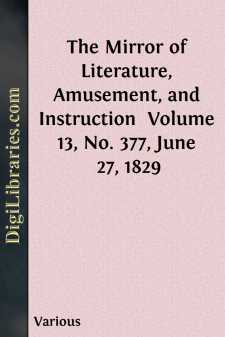Categories
- Antiques & Collectibles 13
- Architecture 36
- Art 48
- Bibles 22
- Biography & Autobiography 813
- Body, Mind & Spirit 142
- Business & Economics 28
- Children's Books 17
- Children's Fiction 14
- Computers 4
- Cooking 94
- Crafts & Hobbies 4
- Drama 346
- Education 46
- Family & Relationships 57
- Fiction 11829
- Games 19
- Gardening 17
- Health & Fitness 34
- History 1377
- House & Home 1
- Humor 147
- Juvenile Fiction 1873
- Juvenile Nonfiction 202
- Language Arts & Disciplines 88
- Law 16
- Literary Collections 686
- Literary Criticism 179
- Mathematics 13
- Medical 41
- Music 40
- Nature 179
- Non-Classifiable 1768
- Performing Arts 7
- Periodicals 1453
- Philosophy 64
- Photography 2
- Poetry 896
- Political Science 203
- Psychology 42
- Reference 154
- Religion 513
- Science 126
- Self-Help 84
- Social Science 81
- Sports & Recreation 34
- Study Aids 3
- Technology & Engineering 59
- Transportation 23
- Travel 463
- True Crime 29
The Mirror of Literature, Amusement, and Instruction Volume 13, No. 377, June 27, 1829
by: Various
Categories:
Description:
Excerpt
Loch Goil Head
AND RESIDENCE OF CAMPBELL, THE POET.
The Engraving represents Loch Goil Head, a small village in Argyleshire, as it name imports, at the end of Loch Goil. It is an exquisite vignette, of Alpine sublimity, and is rendered extremely interesting as the residence of Thomas Campbell, Esq. author of the "Pleasures of Hope," &c. and one of the most celebrated of British poets. His château, or retreat, is represented on the left of the Engraving, and its romantic position has probably inspired many of the soul-stirring compositions of the illustrious resident.
In this parish are the remains of Carrick Castle, which is said to have been built by the Danes. It stands on a rock, and was formerly surrounded
The steam-boat on the lake is an attractive object in such a district as Loch Goil—by associating one of the boasted triumphs of art with the stupendous grandeur of the sublime.
The town of Hillah lies in latitude 32 deg. 31 min. 18 sec.; in longitude 12 min. 36 sec. west of Bagdad, and according to Turkish authorities, was built in the fifth century of the Hegira, in the district of the Euphrates, which the Arabs call El-Ared-Babel. Lying on a part of the site of Babylon, nothing was more likely than that it should be built out of a few of the fragments of that great city. The town is pleasantly situated amidst gardens and groves of date trees; and spreads itself on both sides of the river, where it is connected by a miserable wooden bridge, the timbers of which are so rotten, that they tremble under the foot of the passenger. The portion of the town, or as it is usually called, the suburb, on the eastern bank, consists of one principal street or bazaar, reaching from the small defenceless gate by which it is entered from Bagdad, down to the edge of the water; this is deemed the least considerable part of Hillah. On the other side, the inhabitants, Jews, Turks, and Arabs, are much thicker, and the streets and bazaars more numerous.
From the great central bazaar, well filled with merchandize, branch off in various directions minor ranges, amongst which are found the fish and flesh markets. In the former are several varieties, and some of enormous size, resembling the barbel. The fish in question is from 4 to 5 feet long, and is covered with very large, thick scales. The head is about one-third part of the length of the fish. They are said to eat coarse and dry, but are, nevertheless, a favourite food with the inhabitants; and are caught in great quantities near the town, and to a considerable distance above it. The flesh market is sparingly served with meat, for when Sir Robert Ker Porter visited the town, he states that the whole contents of the market appeared to be no more than the dismembered carcasses of two sheep, two goats, and the red, rough filaments of a buffalo. This display was but scant provision for a population of 7,000. The streets are narrow like those of Bagdad; a necessary evil in Eastern climates, to exclude the power of the sun; but they are even more noisome and filthy....












